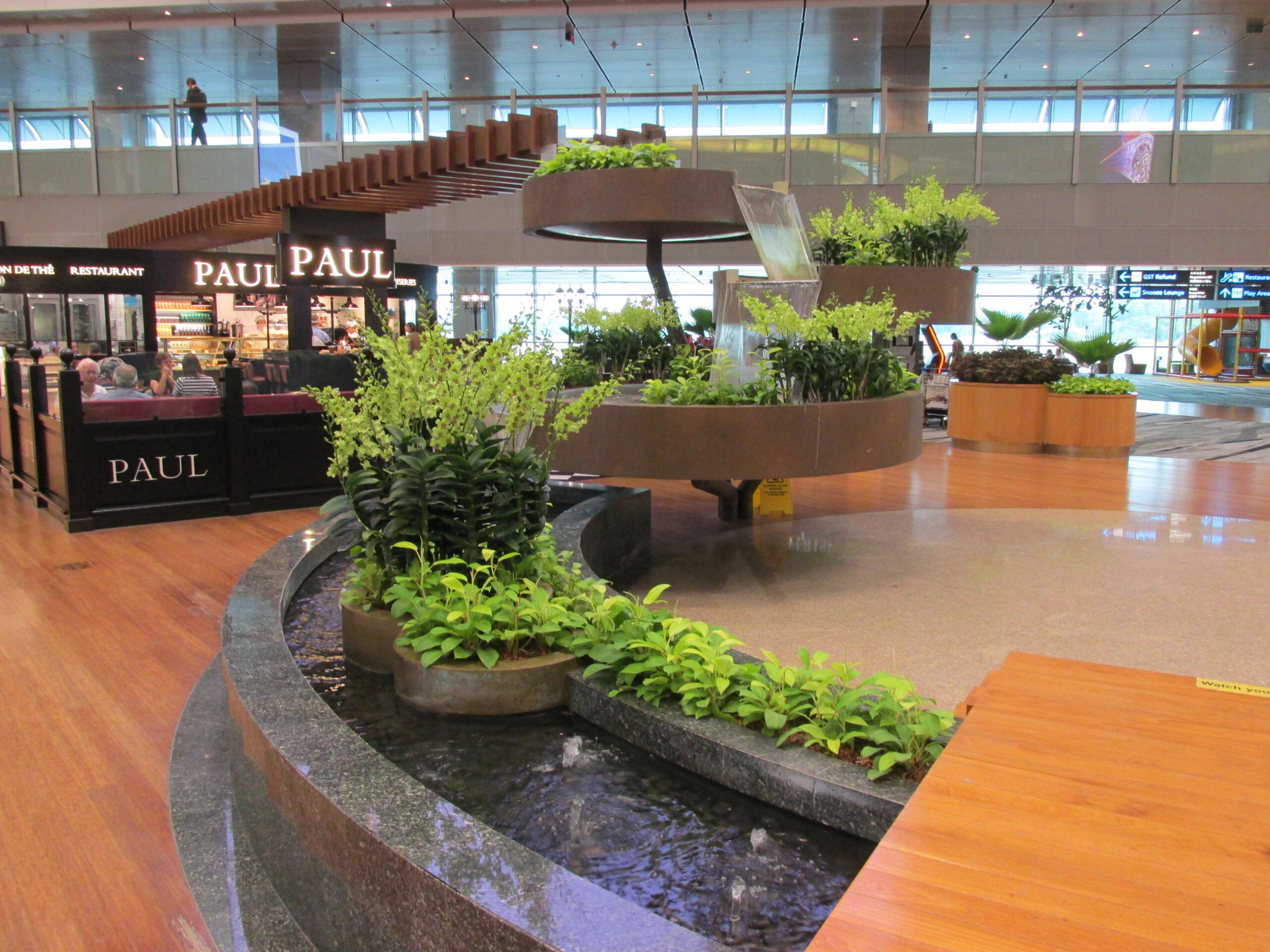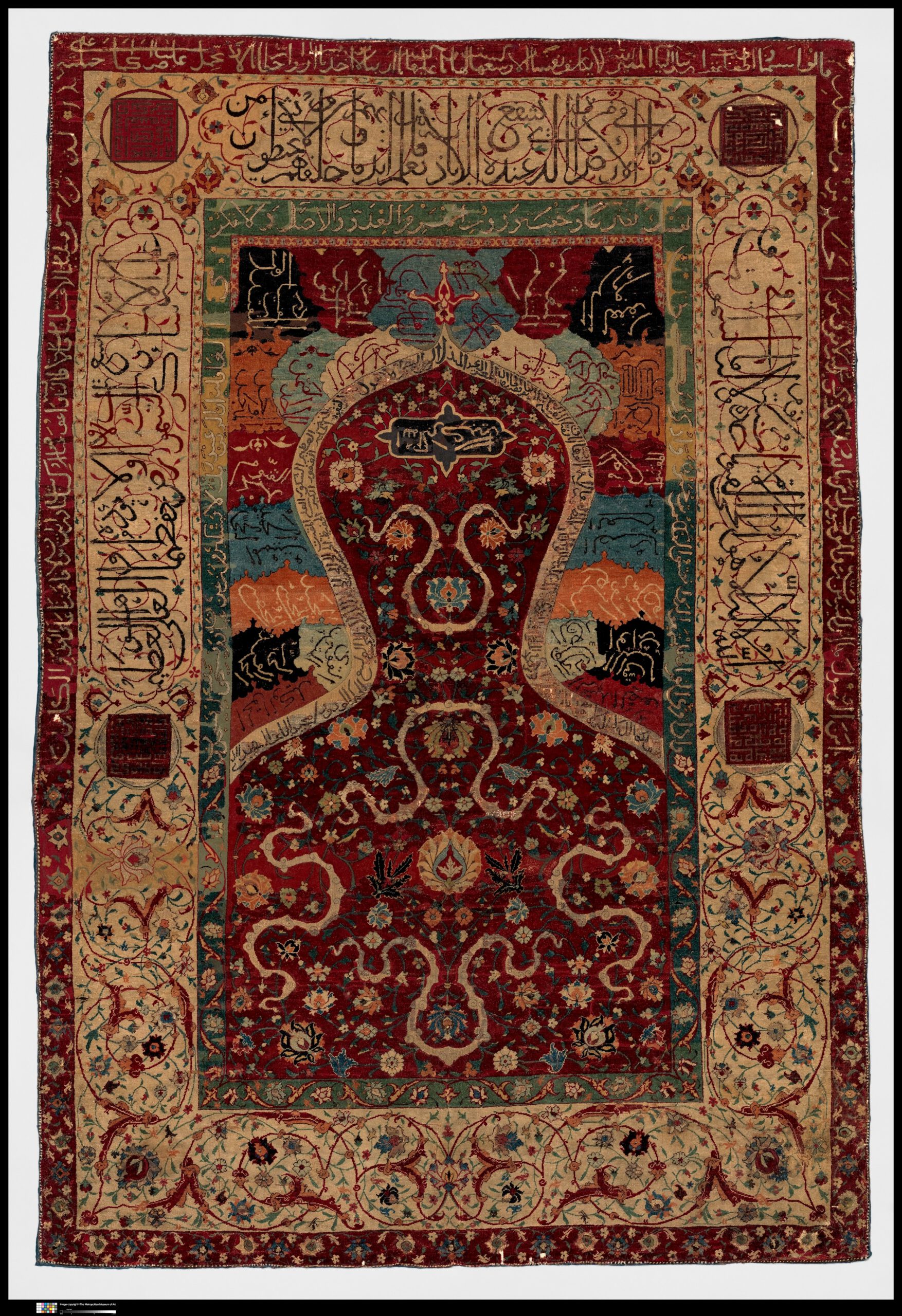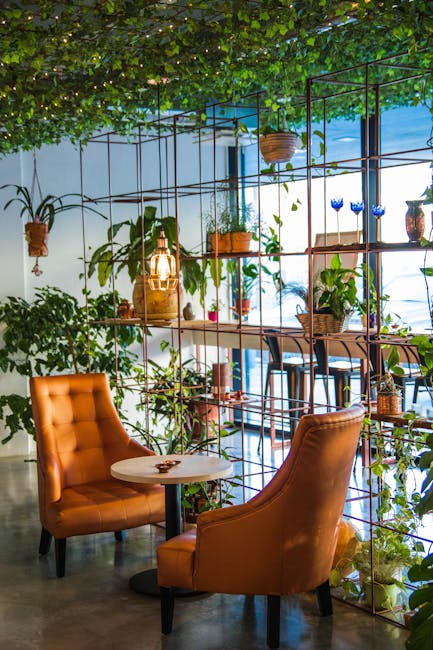Living Walls
Living walls, also known as vertical gardens, are a striking way to bring the essence of nature indoors. These green installations can transform a plain wall into a lush, vibrant display of foliage. Not only do they add a unique aesthetic appeal, but they also improve air quality by filtering toxins and releasing oxygen. Imagine a living wall as a floor-to-ceiling tapestry of leaves, where each plant is a brushstroke of green. They are ideal for urban spaces that lack outdoor gardens, offering a piece of nature in a concrete jungle. Living walls can also be customized to fit any space, whether it’s a small corner in a living room or an entire office lobby. Their cascading greenery can evoke the serenity of a forest, right in the comfort of your home.
Natural Light
Natural light is an essential element in nature-inspired interiors, illuminating spaces with a warm, inviting glow. It creates a connection between the indoors and the outdoors, enhancing the ambiance of any room. Large windows, glass doors, and open layouts are common features that maximize the influx of sunlight. The play of light and shadow throughout the day adds a dynamic quality to interior spaces, much like the changing scenes of nature. Natural light not only enhances mood and productivity but also reduces the need for artificial lighting, making it an eco-friendly choice. By embracing natural light, interiors become more vibrant and full of life, echoing the vitality of the natural world.
Organic Materials
Incorporating organic materials is a fundamental aspect of nature-inspired design. Think of wood, stone, bamboo, and rattan as the building blocks that bring the outdoors in. These materials provide a tactile and visual connection to nature, offering warmth and texture to interiors. Wood with its natural grains and knots tells a story of growth and time, while stone with its cool, smooth surface evokes the permanence of the earth. Organic materials are also versatile, fitting seamlessly into both modern and rustic designs. By using these elements, spaces become grounded and harmonious, reflecting the balance found in nature.
Earth Tones
Earth tones are the color palette of nature, ranging from soft sands and rich browns to deep greens and blues. These hues create a calming and soothing environment, reminiscent of the natural landscapes. Earth tones have the ability to evoke the feeling of being enveloped by nature, whether it’s the warmth of a desert sunset or the coolness of a forest canopy. They are neutral yet impactful, allowing other design elements to shine. By using earth tones, interiors can achieve a timeless elegance that is both comforting and inviting. These colors invite relaxation and reflection, much like a quiet walk in the woods.
Indoor Water Features

Indoor water features, such as fountains and aquariums, introduce the tranquil sounds and sights of water into living spaces. The gentle trickle of water can create a serene atmosphere, promoting relaxation and stress relief. Water features act as focal points, drawing the eye with their movement and sparkle. They can range from elaborate wall fountains to simple tabletop water gardens, each bringing a touch of nature’s fluid beauty indoors. Water has a soothing effect on the mind, reminiscent of a babbling brook or a gentle rain. By incorporating indoor water features, spaces can become peaceful retreats, echoing the tranquility of natural settings.
Biophilic Design
Biophilic design is a holistic approach that seeks to connect people with nature through thoughtful design choices. It emphasizes natural light, materials, and elements to create spaces that nurture and rejuvenate. This design philosophy recognizes the innate human need to interact with nature, promoting well-being and productivity. Biophilic design can be seen in everything from the layout of a room to the choice of colors and textures. It’s about creating a harmonious relationship between humans and their environment, echoing the balance found in nature. By embracing biophilic design, interiors become more than just living spaces; they become sanctuaries that foster a deep connection with the natural world.
Natural Fiber Rugs and Textiles

Natural fiber rugs and textiles bring the soft, tactile qualities of nature into interiors. Materials like wool, cotton, jute, and sisal offer warmth and comfort, grounding spaces with their earthy textures. These textiles are not only visually appealing but also sustainable, often produced with eco-friendly practices. Natural fibers can be woven into intricate patterns or left in their raw, unprocessed state, each offering a unique aesthetic. They evoke the softness of a meadow or the roughness of a sandy beach, adding depth and character to a room. By incorporating natural fiber rugs and textiles, spaces become cozy and inviting, mirroring the comfort found in nature.
Stone Accents
Stone accents, whether in the form of countertops, fireplace surrounds, or decorative features, bring the timeless strength of the earth into interiors. Stone surfaces can be polished and sleek or rough and rugged, each with its own distinct charm. They provide a cool contrast to the warmth of wood and textiles, creating a balanced interplay of materials. Stone can evoke the grandeur of a mountain range or the subtle elegance of a pebble-strewn riverbed. By using stone accents, interiors gain a sense of permanence and stability, reflecting the enduring beauty of the natural world.
Wooden Beams and Ceilings
Wooden beams and ceilings add a rustic charm to modern interiors, reminiscent of woodland cabins and country homes. Exposed beams highlight the architectural structure of a space, offering a glimpse of craftsmanship and history. Wood ceilings can be left natural or stained to enhance their grain, adding warmth and character to a room. They evoke the feeling of being nestled in a forest, where the canopy of trees shelters and protects. Wooden beams and ceilings bring a sense of coziness and intimacy, inviting relaxation and reflection. By incorporating these elements, interiors become welcoming havens, echoing the sheltering embrace of nature.
Large Potted Plants
Large potted plants are a simple yet effective way to introduce greenery into interiors. They act as living sculptures, adding height, color, and texture to a space. Plants like fiddle leaf figs, monstera, and palms can transform a room with their lush foliage, creating a mini indoor jungle. Not only do they enhance aesthetics, but they also purify the air and improve humidity levels. Large potted plants can serve as focal points or complement other design elements, adding a touch of nature’s beauty to any corner. By integrating plants into interiors, spaces become vibrant and full of life, much like a flourishing garden.
Nature-Inspired Art
Nature-inspired art captures the beauty and diversity of the natural world, bringing it into the home through paintings, sculptures, and photographs. Artwork featuring landscapes, wildlife, or botanical subjects can evoke the serenity of nature, offering a visual escape from urban life. These pieces can range from realistic depictions to abstract interpretations, each celebrating the wonders of the natural environment. Nature-inspired art can serve as a conversation starter, inviting viewers to reflect on their own connection to the outdoors. By incorporating such art, interiors become enriched with the inspiration and tranquility of nature’s artistry.
Recycled and Sustainable Materials
Recycled and sustainable materials are a testament to the growing awareness of environmental responsibility in interior design. Using materials like reclaimed wood, recycled glass, and repurposed metal not only reduces waste but also adds a unique character to a space. These materials have a history and story to tell, adding depth and authenticity to interiors. Sustainable choices reflect a commitment to preserving the planet’s resources, echoing the cycles and renewals found in nature. By integrating recycled and sustainable materials, interiors become not only beautiful but also mindful, embodying the principles of conservation and respect for the environment.
Open Shelving with Natural Elements
Open shelving with natural elements offers a versatile way to display personal treasures and organic finds. Shelves can be adorned with driftwood, seashells, potted succulents, or handmade ceramics, each adding a touch of nature’s charm. Open shelving invites creativity and personalization, allowing for easy rearrangement and seasonal updates. It provides an opportunity to showcase collections and memories, creating a dynamic and ever-evolving display. Natural elements on shelves can evoke the feeling of a curated nature exhibit, where each piece tells a story. By incorporating open shelving with natural elements, interiors become personalized sanctuaries that reflect the beauty and diversity of the natural world.
Natural Stone Tiles
Natural stone tiles bring the rugged beauty of the earth into interior spaces, offering a durable and elegant flooring option. Each tile is unique, with its own patterns and colors, much like the varied landscapes of nature. Stone tiles can be used in kitchens, bathrooms, or entryways, providing a cool, hard surface that contrasts beautifully with softer furnishings. They evoke the feeling of walking on a mountain path or a rocky shoreline, connecting the indoors with the great outdoors. By using natural stone tiles, interiors gain a sense of authenticity and timelessness, echoing the enduring beauty of the natural world.
Skylights and Sun Tunnels
Skylights and sun tunnels bring the sky indoors, flooding spaces with natural light and offering a glimpse of the changing weather and passing clouds. These architectural features create a direct connection between the interior and the heavens above, enhancing the feeling of openness and freedom. Skylights can transform a dark, enclosed space into a bright and airy retreat, much like stepping into a sun-dappled glade. Sun tunnels capture and direct sunlight into areas that would otherwise remain in shadow, illuminating spaces with a warm, natural glow. By incorporating skylights and sun tunnels, interiors become infused with nature’s light and energy, enhancing the overall ambiance and well-being.
Indoor-Outdoor Flow
Indoor-outdoor flow is a design concept that blurs the boundaries between indoor and outdoor spaces, creating a seamless transition between the two. This can be achieved through large sliding doors, continuous flooring, and cohesive design elements that extend from the interior to the exterior. The goal is to create a harmonious relationship with the natural surroundings, allowing for easy access and interaction with the outdoors. Indoor-outdoor flow enhances the feeling of spaciousness and freedom, much like living in a pavilion open to the elements. By embracing this design concept, interiors become part of a larger ecosystem, connected to the rhythms and beauty of the natural world.
Botanical Prints
Botanical prints bring the intricate beauty of plants and flowers into interiors through art and textiles. These prints can range from detailed scientific illustrations to vibrant, abstract patterns, each celebrating the diversity of the plant kingdom. Botanical prints can be used on wallpaper, cushions, or curtains, adding a touch of nature’s elegance to any room. They evoke the feeling of being surrounded by a garden in full bloom, offering a visual feast for the eyes. By incorporating botanical prints, interiors become enriched with the colors and forms of nature, inviting a sense of wonder and appreciation for the natural world.
Rustic Furniture
Rustic furniture embodies the simplicity and charm of rural life, bringing the warmth and character of the countryside into interiors. Made from natural materials like wood and metal, rustic furniture often features weathered finishes and handcrafted details. These pieces evoke the feeling of a cozy cabin or farmhouse, where comfort and functionality reign supreme. Rustic furniture can range from sturdy dining tables to plush armchairs, each adding a touch of nature’s rugged beauty to a space. By incorporating rustic furniture, interiors become inviting and down-to-earth, reflecting the unpretentious charm of the natural world.
Natural Air Purifiers
Natural air purifiers, such as certain plants and salt lamps, offer a way to improve indoor air quality while adding a touch of nature to interiors. Plants like peace lilies, snake plants, and spider plants are known for their ability to filter toxins and release oxygen, creating a healthier environment. Salt lamps, made from Himalayan salt crystals, emit a warm glow and are believed to have air-purifying properties. These natural elements not only enhance aesthetics but also promote well-being and relaxation. By incorporating natural air purifiers, interiors become healthier and more serene, echoing the freshness and vitality of the natural world.
Water Views
Water views offer a direct connection to the calming and restorative qualities of water, providing a sense of tranquility and escape. Whether it’s a view of the ocean, a lake, or a river, water vistas can enhance the ambiance of a space, much like a window to a serene landscape. Water views invite contemplation and reflection, offering a visual retreat from the hustle and bustle of daily life. By incorporating water views into interiors, spaces become more than just rooms; they become portals to the peaceful and rejuvenating world of nature.

Renowned for her warm and inviting aesthetic, Joanna Gainsley has revolutionized modern farmhouse design. In The Cozy Home Guide, she shares practical tips on how to make any space feel like a sanctuary.

